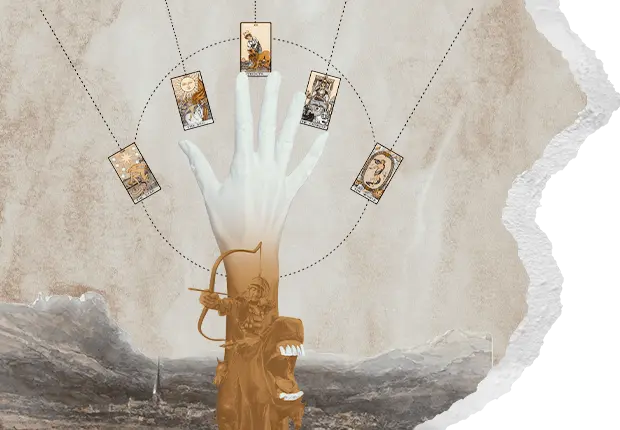Res Ipsa Loquitur
I’m a big fan of the saying res ipsa loquitur—the thing speaks for itself. In a legal context it means that the facts point to a conclusion so obvious that no further deliberation – let alone belabored cogitation – is required. A smoking gun, if you will. The past generation of elite thinkers has fully abandoned this common-sense approach to reality. Instead we’re treated to the “Actually…”-brand of history by a pontificate of over-weaned charlatans, waxing pedantic their ad hominem critiques masquerading as scholarship. This is truest in the way the elites explain away the success of Western masculinity. Instead of the sine qua non of civilization, it’s an invariably toxic vestige of the wilderness that now requires domestication.
And yet I wonder if we haven’t put this specious critique to rest because, until recently, we haven’t reliably understood the origin of Western masculinity and why it’s been so successful. All that has changed, though, in the last eight years. A revolution in ancient DNA and a wholesale re-writing of the archaeological record now convincingly sheds light on who, precisely, our ancestors were: the Indo-Europeans.
Until recently there was only speculation about the origin of the Indo-European language family. In American academic circles this problem was relegated to second-tier status by post-modernists. Even where it did arise it required the imprimatur of an anti-colonial, anti-patriarchal critique to be permissible for discussion. As a result the field went stagnant. However, as often happens with stagnant fields, the stale assumptions and debates have been blown open by the novel field of archaeogenetics, which now connects in fine detail the first speakers of Proto-Indo-European (the Yamnaya) to a burst of migration around 3300BC from the Eurasian Steppes. Over the next five-thousand years their successors came to dominate almost all the world and account for nearly half of its people. If we do have a progenitor culture that explains why we are the way we are, it’s them.
It took a revolution in DNA to connect the dots, but knowledge of the Yamnaya Culture and their connection to pastoralism, horse domestication and the Proto-Indo-European language has been available to archaeologists and linguists for some time. We now know that our ancestors arose as a relatively small tribe in today’s Ukraine/Russia as early as 4000BC. They were the first to domesticate the ancestor of the modern horse; they were the first to practice herding large stocks of cattle; they were the first to ride horses (though not into combat—that took many more centuries); and they were the first to speak a language that we all share part of as a result.
They innovated movable wealth (cattle) and became sufficiently prosperous to expand, coming to dominate the Danubian and Hungarian Plains. Thereafter, their closely affiliated relatives (known as the Corded Ware Culture) spread through northern Europe by similar means, while another branch (the Bell Beaker Culture) continued expanding from the Rhine to Portugal as well as completely overrunning the British Isles. All this took about a thousand years and did not stop until several other branches had settled as far south as Italy (the Italo-Celts), the Peloponnese (Catacomb Culture), and one adventurous branch even travelled from the Baltic to the Urals and down into Iran and eventually India. By about 1200BC Indo-European languages were heard from the Atlantic to the Indian Oceans, and from the Arctic to the Mediterranean Seas. This formidable expansion would be repeated in the Age of Discovery, extending Indo-European cultures nearly everywhere on the globe.
It has become cloyingly canonical among the Elites to point out that this expansion was (gasp!) violent and thus bad, and by extension the Indo-Europeans were also bad.
And yet they conquered the whole world… not a bad record. Res ipsa loquitur?
There’s more than a history lesson in all of this. The Indo-European culture not only gave birth to a host of languages and cultures that today we call our own, it also birthed a new kind of men: men adaptable to rapidly changing circumstances; men ready to take enormous personal and physical risks to reap unprecedented rewards; men forced to reckon with novel problems like dealing with property; men unwilling to bow to anyone simply on account of proximity or rumored supernatural favor. There’s a reason why we see these tropes again and again in tales of grand exploits and derring-do, whether mythic or historical: This is the patrimony bequeathed by the men of the steppes, the Yamnaya, and each one of us that has inherited their genes, or aspires to their cultural podium, can claim a part.
That Indo-European culture was patriarchal has never been in doubt. And after the Nazis defamed this culture to justify some of the evilest acts in history, academics were naturally solicitous to steer their conclusions away from glorifying them at all. By the 1960s this meant shading any Indo-European discourse as problematic. One of the most famous such “shaders” was Marija Gimbutas, a brilliant archaeologist, who characterized their advance through Europe as a misogynistic orgy of rapine against the peace-loving moon-maidens of “Old Europe’s” farming cultures. In fairness she is not solely responsible for propagating that Leftist fantasy, but it nonetheless did her a disservice as later discoveries showed that almost all of Old Europe’s farming societies were patriarchal and violent. Nor is there any consensus that the advance of the Indo-Europeans was a pre-dominantly violent affair. Indo-European patriarchy was different though; Indo-European men were a breed of their own, nevertheless.
Farmers are sedentary, their lives immutable to all but the revolving seasons. They tilled preferred soils until exhaustion, husbanded small livestock (though the endemic zoonotic pathogens would be their bane) and lived a communal life with ritual practices focused on the Earth-Mother and her idols. Neither exogenous violence nor slavery were unknown to them. These were no moon-maidens. They themselves had overrun the lands once freely foraged by hunter-gatherers since the end of the last Ice Age. Their main advantage: demographics. Despite high infant mortality and disease, and the vicissitudes of subsistence agriculture they multiplied much faster than the hunter-gatherers (with their small families, confined to the forests and hills).
Neither farmer nor hunter-gatherer was prepared for the advent of the steppe pastoralist. Our ancestors had hunted, fished and farmed but as their prospects dried-up with the changing climate they turned to the apparent wastelands of grass between the fertile river valleys of the Pontic Steppe. There they had one advantage: horses. First domesticated for their meat, there is evidence our ancestors learned to tame and ride them even before 3000BC. While riding doesn’t seem to be widespread until later, its introduction surely changed the calculus of steppe survival. Now instead of a wasteland it was a colossal grazing zone; instead of small herds of livestock a man could aspire to range hundreds of head of cattle; instead of risking certain death to raid a neighboring settlement a man and his companions could sneak up on horseback and ride off without being caught.
The impact this had on men of the Yamnaya Culture can hardly be understated. Hunter-Gatherers thought in terms of zero-sum games and clever gambits to catch their next meal; farming societies relied on the (hopefully) reliable ebb and flow of the seasons for theirs. The steppe pastoralist needed no such gambits nor seasonal reliability. He made his own luck.
The odds, though, were not short, and the pastoralist life—if taken to its logical conclusion—entailed enormous risks. Men would have invented new forms of violence and new forms of cooperation. A larger herd meant sons or brothers would be needed to help protect family wealth from other clans or outsiders. Family loyalty now paid a premium and was in turn compensated by notions of inheritance between the generations. Consolidating wealth over multiple generations now became a thing. The giving of mighty gifts was now possible for a people once eking out a living amidst the reeds and rushes of the Don and Dniepr Rivers. Now distant political alliances could be consummated. And rewards were not simply counted in material possessions: the memory of wealth and influence could endure long after death with the raising of large funerary mounds, called kurgans or tumuli, that still pierce the steppe horizon to this day.
An Indo-European ethos emerged. The reward offered was unprecedented wealth and eternal memory. To inculcate this ethos young men turned to the koryos, a warband of sorts dedicated to a variety of manly pursuits, of which warfare and cattle-rustling were given primacy. The koryos not only offered young men a chance to hone war-craft but also a brotherhood of mentors across lines of kinship. It offered young men membership in a secret society, bound together through ritualized canine consumption—which was otherwise taboo. It also offered men a means of trusted communication across the vast geographies of conquest.
As long as there were new lands and new shores the Indo-Europeans continued to advance. At times their culture progressed by intermarriage, their women sometimes taking that culture and rooting it in foreign lands, as they did with the Corded Ware Culture. Other times they advanced by the edge of the sword, replacing entire extant male populations, as they did in the British Isles. And yet other times it was something in between. The success of the Indo-European advance wasn’t limited to violence. Their culture exalted deeds worthy of memory along with material possessions—an appealing combination to mimic for foreign tribes in terminal decline—thus many of them adopted Indo-European culture by choice.
From about 3300BC—when the expansion began—until about 2300BC a common cultural thread connected peoples from the Iberian Peninsula to the Caspian (it would continue to the Zagros Mountains and to the Ganges River within another thousand years). It was in that time the steppe man and his ethos came to dominate.
Who was this steppe ancestor and what was his ethos? Forget cartoonish notions of blond-haired, blue-eyed ubermenschen—the Yamnaya and their kin were (mostly) dark haired and brown eyed. Foremost, he was a free man. In fact the term many eventually applied to themselves was Aryan, which means something like “free men”. Generations spent grazing the endless steppes endowed his soul with the uncountably facultative possibilities of a horizon that requires only the will to move forward. In other words, total freedom.
And while the tamed horse might have sutured those possibilities to the present, only a prepared man could survive on that wind-blasted expanse. The steppe man had to know self-reliance (even with a tightly-knit network of kinsmen to help). He was at the mercy of the sky (probably why the Shining Sky-Father was his most revered God) and he was comfortable on his own. He would also have been a skilled engineer, wagon construction and repair being as essential as open-country survival.
Knowledge of self-defense and the concomitant will to defend would have been a further necessity of manhood, not merely against wolves, but against raiders; and not merely to protect one’s body but to preserve the herd and the patrimony it represented. Moreover, with the invention of movable property he had to know self-defense of a different sort. He had to be canny and shrewd, guard against deception but also be open to opportunities for swift profit. He had to know when to expect an attack and when others might take advantage of him. Even dulled by centuries of comfortable civilization this instinct still lurks within us, like Tony Soprano waking from a Prozac-induced stupor, realizing he’s about to be assassinated. For us the instinct for resourceful self-preservation lies dormant until it bucks like a stallion at the moment it’s needed.
While a new ethos governed their conscience new hierarchies were called for to govern their relationships with each other. There is a good reason why the word ‘king’ is derived from ‘kin’—heritable offices required kinship to ensure trust and secure the transfer of property between generations. But the first “kings” were not what we mean by that word today. As clans became tribes and tribes became nations, kinship was insufficient to provide good governance. King, in the sense of kinship, evolved into a peace-time office with a very small ambit of authority, even if held for life. During times of conflict, where unity between fractious clans was critical, military “kings” would be elected with vast powers—though only until the end of the conflict (think of the Roman dictator or the Germanic dux).
And still the Indo-European man devised more notions for the equitable governance of clans, tribes and nations. These men knew that it was not enough to ensure the prosperity of an entire people with kin-based or war-exigent leaders. In time another leader, a true ruler, would be needed. More than being a respected elder or great warrior, he would need to know the arts of guile and compromise to herd and wield a fissiparous flock. This archetype of leader arose not by forcing his peers’ submission but only after gaining their respect by judicious arbitration of their conflicts. Hence the words “reich”, “rex”, “rule” and “right” all have the same origin.
In Indo-European society a man was a person who was free, who could survive and defend himself and his family, and who could rule justly with the respect of other men. In this elegant hierarchy the Indo-Europeans invented not only a society to stand the test of time but the principles of governing that society with wisdom and mutual consent.
My purpose now is not to delineate every detrimental factor that has attached to Indo-European masculinity since its inception. Instead I wish to draw attention to an archetypal cancer that continues to gnaw away at this ethos, as it has done for thousands of years.
Perhaps the simplest explanation is that Indo-European masculinity arose on the steppes as an adaptation to a particular set of persistent circumstances. The further away from its source, the more challenges it faced in adapting.
The first challenge came when dominating the farming peoples of Old Europe. These were peoples that had settled the arable parts of Europe (from the Bosporus to the Orkneys) between about 6600BC and 4400BC. The farming lifestyle was utterly at odds with that of the pastoralist and in many—though not all—cases those with steppe ancestry came to occupy elite positions. But now, living in new climates and topography, the Indo-Europeans struggled to adjust. We know they burned the forests to replicate the grazing lands they were accustomed to. They adapted their burial techniques. They acquired metal-craft. However they would never be inured to laboring the fields as Old Europe’s farmers were wont. This created a perpetual restlessness among their mixed descendants who did till the earth but felt an untoward predilection in their souls for risk-taking, opportunity-seizing and adventure. Perhaps it is this yearning that inspired the first bards to recite epic poetry.
Romantic notions aside, there were other challenges to Indo-European masculinity. Foremost was governance. The first paradigm of rule was introduced from the dazzling cities of Mesopotamia, where temples, palaces and libraries were first erected, and where God-Kings sat as Lords over their subjects. In semitic languages the meaning of ‘lordship’ is ensconced within the meaning of the divine. It is the reification of sovereignty and the transmutation of divinity into flesh, thus the relationship between ruler and ruled was akin to that of God and His people. Lordship, however, was anathema to the Indo-European constitution. Certainly the king, chief, dux or rex were all to be obeyed, but authority had been constructed from the ground up, first from kinship and then by enforced respect among power brokers, through mutually agreed settlements. The Indo-European man bowed but he did not kneel.
Religion was another challenge. While some religious aspects of the farming societies were absorbed (Classical Greece is replete with them), most successor societies adopted the Indo-European pantheon of the Shining Sky-Father (Dyeus Pter). These were religions of ritual, where offerings were made to deities in sacred precincts. This created enormous flexibility as their religion could accommodate more and more foreign cults and practices, much as the English language has done with foreign words.
But eastern religious cults were very different. Semitic sects evolved into religions of belief, perhaps owing to their reduction to monotheism. Monotheism necessarily cannot tolerate the existence of outside religious practices (let alone beliefs) and evolved a canonical morality. With any canon comes a necessary caste of interpreters—a bureaucracy of priests and other specialists whose roles are often at odds with heroic society.
Thus when eastern religions were foisted upon the decaying Roman Empires the result was an unprecedented weaponization of spirituality. Alongside arose a non-productive priestly caste that vitiated the authority of rulers to the detriment of every estate in society. And so began a paradoxical power struggle where rulers were anointed by priests, but resented the lien on their authority; free people buckled under the unnatural constraint of sovereign submission; and the wielders of arcane power (priests and the literate) found themselves in a vise between two groups historically prone to violence. Nothing has truly been settled in the West since. Which brings us to the present.
Seen this way, the period between Late Antiquity and the Enlightenment was a time of chaos in search of a settlement, all on account of the imposition of an unnatural way of thinking and governing. None of this is to say the Indo-European ethos was stanched. New frontiers were discovered and exploited, new adventures taken and the rebellious spirit continued its fight against the stifling sedentism of monotheism and lordly rule.
The novel political settlements of the Enlightenment restored many of the natural notions of self-governance and mutual consent from the Indo-European era—though adapted to the Modern Era’s unprecedented material prosperity. We are now victims of that prosperity.
Western society has been seduced by a cynical class of Elites to believe the status quo is permanent. Instead of recognizing that the last half-millennium of human improvement was a fortuitous blip on the radar of history, their high priests have proclaimed that the End of History is nigh. Perhaps there is a kernel of truth in that. It may also be that the Indo-European ethos requires new frontiers to release its creative energies, and much like Alexander we are told that we have no more worlds to conquer.
Now almost every institution in Western society acts against the Indo-European ethos in concert. Government bureaucracies regulate even the smallest aspects of daily life, a disenfranchisement we’re told is imperative to satisfy the nebulous god Safety and ward off her opaque nemesis Harm. Hosts of expensively-trained experts labor over the most arcane ways to enforce conformity, condemning those once revered as heroes with the most meretricious screeds. Enterprise no longer assumes risk—capital having been consolidated in the largest corporations so hermetically that it is indistinguishable from the government that allowed it to coalesce in the first place. The Enlightenment Era settlement has finally turned inward and simply feeds off the dwindling few who labor under the pretense that risk and work will yield returns, both material and aethereal. It segregates an ever-larger part of society into non-productive client-castes, providing them with an expectation (much as it did with Old Europe’s farmers) that prosperity will be guaranteed to the obedient just like the harvests (in diminished cadence, of course). All that is required is an unlimited offering to the new Gods. A bit like a Disney+ subscription.
It’s no wonder the socio-political views of men are rapidly diverging away from the old settlement—a breached social contract that rejects five-thousand years of arguably the most successful behavioral adaptation in history. The new, imposed, settlement is a return to temple-based divine lordship over a passive flock of worker-drones: a permanent and impermeable ruling caste of rent-seekers, constantly moving the goal-posts with lip-service about expert-contrived catastrophes. And the more words they burn to excuse the avoidable decline of prosperity, the more the smoke reveals their obvious swindle. The thing itself is revealed in all its lies.
But this cannot last. The Laws of Thermodynamics forbid it, for one. The Indo-European ethos that most of us carry cannot be bested, it is too engrained in us, if not in our genes then in our instincts and our souls. And much like our steppe ancestors, it’s telling us something is badly awry. Shadows move on the horizon. Our spines stiffen without thought. Pupils and veins dilate. Our breathing shakes off its torpor. The men of Indo-European patrimony, and the many women who hold that heritage dear, will stand long. The chaotic Laws of Nature, being more cyclical than steady, already present the brazen with new lands and new horizons. We will not submit. Our patrimony will be the one that endures.
A.J.R. Klopp has been a hedge fund trader, a corporate attorney and an astrophysicist. He is most recently the author of The Toll of Fortune: An Indo-European Origin Saga. Learn more at https://13fathers.com/ or https://x.com/ThirteenFathers.
































